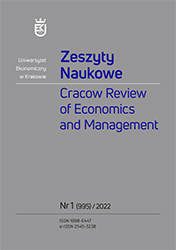A Method for Assessing Leadership Competences
DOI:
https://doi.org/10.15678/ZNUEK.2022.0995.0107Keywords:
leadership, leadership competences, assessing, methods of assessingAbstract
Objective: The article proposes a method for assessing the level of leadership competences using a range of assessment criteria. The following research question was adopted: How can the level of leadership competencies be assessed reliably based on the evaluation criteria adopted, and with a synthetic approach (in cross-sections of criteria groups and all criteria jointly)? Leaders’ behaviour was the criterion adopted for assessing the level of leadership competences.
Research Design & Methods: Following a presentation of other methods that have been used to assess leadership competences, the multi-criteria method proposed for this paper was based on Roy’s concept of complete aggregation. The method makes it possible to assess the level of leadership competences in the breakdowns included in the research problem. Literature studies and a scientific description were used as general research methods.
Findings: The result of the research is a procedure for assessing leadership competences using Roy’s complete aggregation, adapted to the requirements of the adopted research problem. It offers the additional possibility of formalising the assessment of leadership competences.
Implications / Recommendations: The results of the research allow us to assume that the proposed procedure makes it possible to assess, in the practice of organisation management, the level of leadership competences in various cross-sections of the criteria for their evaluation. However, the final decisions on the assessment of that level in people, on the basis of the results of the adopted procedure, will be made by humans.
Contribution: The author’s proposal contributes to the theory on leadership competences, offers practical guidance on filling leadership positions in an organisation and determining training needs.
Downloads
References
Armstrong M. (2000), Zarządzanie zasobami ludzkimi, Oficyna Ekonomiczna, Kraków.
Baczyńska A. (2018), Menedżerowie czy przywódcy. Studium teoretyczno-empiryczne, Poltext, Warszawa.
Bandura A. (1977), Self-efficacy: Toward a Unifying Theory of Behavioral Change, „Psychological Review”, vol. 84(2), https://doi.org/10.1037/0033-295X.84.2.191. DOI: https://doi.org/10.1037//0033-295X.84.2.191
Charan R., Drotter S.N., Noel J.L., (2000), The Leadership Pipeline: How to Build the Leadership Powered Company, Jossey-Bass, San Francisco.
Chomątowski S., Sokołowski A. (1978), Taksonomia struktur, „Przegląd Statystyczny”, nr 2.
Ciuk S. (2016), Nowe kierunki w badaniach nad przywództwem (w:) Nowe kierunki w organizacji i zarządzaniu. Organizacje, konteksty, procesy zarządzania, red. B. Glinka, M. Kostera, Wolters Kluwer, Warszawa.
Drotter S.J., Charan R. (2001), Building Leaders at Every Level, „Ivey Business Journal”, vol. 65(5).
Foti R.J., Hauenstein N.M.A. (2007), Pattern and Variable Approaches in Leadership Emergence and Effectiveness, „Journal of Applied Psychology”, vol. 92(2), https://doi.org/10.1037/0021-9010.92.2.347. DOI: https://doi.org/10.1037/0021-9010.92.2.347
Griffin R.W. (1996), Podstawy zarządzania organizacjami, Wydawnictwo Naukowe PWN, Warszawa.
Grobler S.W., du Plessis Y. (2016), Requisite Leader Behavioural Competencies for Sustainable Organisational Performance, „Acta Commerci”, vol. 16(1), https://doi.org/10.4102/ac.v16i1.347. DOI: https://doi.org/10.4102/ac.v16i1.347
Hogan R., Kaiser R.B. (2005), What We Know About Leadership, „Review of General Psychology”, vol. 9(2), https://doi.org/10.1037/1089-2680.9.2.169. DOI: https://doi.org/10.1037/1089-2680.9.2.169
Judge T.A., Ilies R. (2002), Relationship of Personality to Performance Motivation: A Meta-Analytic Review, „Journal of Applied Psychology”, vol. 87(4), https://doi.org/10.1037/0021-9010.87.4.797. DOI: https://doi.org/10.1037//0021-9010.87.4.797
Judge T.A., Piccolo R.F. (2004), Transformational and Transactional Leadership: A Meta-Analytic Test of Their Relative Validity, „Journal of Applied Psychology”, vol. 89(5), https://doi.org/10.1037/0021-9010.89.5.755. DOI: https://doi.org/10.1037/0021-9010.89.5.755
Kaiser R.B., Craig S.B. (2000), What Gets You There Won’t Keep You There: Managerial Behaviours Related to Effectiveness at the Bottom, Middle, and Top, 18th Annual Conference of the Society for Industrial and Organizational Psychology, Chicago, Illinois.
Klemp Jr G.O. (1980), The Assessment of Occupational Competence. Final Report: I. Introduction and Overview, National Institute of Education, Washington.
Kolman R. (1973), Ilościowe określanie jakości, PWE, Warszawa.
Koźmiński A.K. (2013), Ograniczone przywództwo. Studium empiryczne, Poltext, Warszawa.
Kupczyk T. (2013), Kompetencje kadry kierowniczej w gospodarce opartej na wiedzy, Difin, Warszawa.
Levinson H. (2007), Psychologia przywództwa, Helion, Gliwice.
McDaniel E.A. (2002), Senior Leadership in Higher Education: An Outcomes Approach, „Journal of Leadership & Organizational Studies”, vol. 9(2), https://doi.org/10.1177/107179190200900207. DOI: https://doi.org/10.1177/107179190200900207
Mischel W., Shoda Y. (1995), A Cognitive-Effective System Theory of Personality Reconceptualizing Situations, Dispositions, Dynamics, and Invariance in Personality Structure, „Psychological Review”, vol. 102(2), https://doi.org/10.1037/0033-295X.102.2.246. DOI: https://doi.org/10.1037//0033-295X.102.2.246
Olkiewicz M. (2015), Kompetencje menedżera jako determinanta rozwoju organizacji, „Ekonomika i Organizacja Przedsiębiorstwa”, nr 7.
Pluta W. (1986), Wielowymiarowa analiza jakości, Wydawnictwo Naukowe PWN, Warszawa.
Roy B. (1990), Wielokryterialne wspomaganie decyzji, WNT, Warszawa.
Seiler S., Pfister A.C. (2009), „Why Did I Do This?”: Understanding Leadership Behaviour Trough a Dynamic Five-Factor Model of Leadership, „Journal of Leadership Studies”, vol. 3(3), http://dx.doi.org/10.1002/jls.20122. DOI: https://doi.org/10.1002/jls.20122
Słownik zarządzania kadrami (2005), red. T. Listwan, Wydawnictwo C.H. Beck, Warszawa.
Stogdill R.M. (1948), Personal Factors Associated with Leadership: A Survey of the Literature, „The Journal of Psychology”, vol. 1(25), https://www.tandfonline.com/doi/abs/10.1080/00223980.1948.9917362. DOI: https://doi.org/10.1080/00223980.1948.9917362
Suchar M. (2009), Rekrutacja i selekcja pracowników, Wydawnictwo C.H. Beck, Warszawa.
Taksonomia struktur w badaniach regionalnych (1998), red. D. Strahl, Wydawnictwo Akademii Ekonomicznej we Wrocławiu, Wrocław.
Tett R.P., Burnett D.D. (2003), A Personality Trait-Based Interactionist Model of Job Performance, „Journal of Applied Psychology”, vol. 88(3), https://doi.org/10.1037/0021-9010.88.3.500. DOI: https://doi.org/10.1037/0021-9010.88.3.500
Tett R.P., Guterman H.A. (2000), Situation Trait Relevance, Trait Expression, and Cross-situational Consistency: Tesking a Principle of Trait Activation, „Journal of Research in Personality”, vol. 34(4), https://doi.org/10.1006/jrpe.2000.2292. DOI: https://doi.org/10.1006/jrpe.2000.2292
Thompson J., Cole M. (1997), Strategic Competency – the Learning Challenge, „Journal of Workplace Learning”, vol. 9(5), https://doi.org/10.1108/13665629710169611. DOI: https://doi.org/10.1108/13665629710169611
Van Iddekinge C.H., Ferris G.R., Heffner T.S. (2009), Test of a Multistage Model of Distal and Proximal Antecedents of Leader Performance, „Personnel Psychology”, vol. 62(3), https://doi.org/10.1111/j.1744-6570.2009.01145.x. DOI: https://doi.org/10.1111/j.1744-6570.2009.01145.x
Yukl G.A. (1989), Leadership in Organizations, Prentice-Hall, Englewood Cliffs, New York.
Downloads
Published
Issue
Section
License
Copyright (c) 2022 Zeszyty Naukowe Uniwersytetu Ekonomicznego w Krakowie / Cracow Review of Economics and Management

This work is licensed under a Creative Commons Attribution 4.0 International License.

